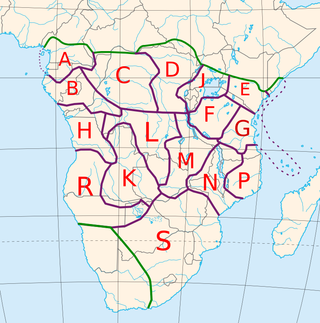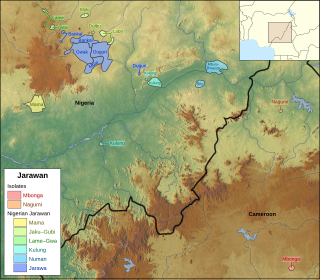Related Research Articles

The Bantu languages are a language family of about 600 languages that are spoken by the Bantu peoples of Central, Southern, Eastern and Southeast Africa. They form the largest branch of the Southern Bantoid languages.
Clement Martyn Doke was a South African linguist working mainly on African languages. Realizing that the grammatical structures of Bantu languages are quite different from those of European languages, he was one of the first African linguists of his time to abandon the Euro-centric approach to language description for a more locally grounded one. A most prolific writer, he published a string of grammars, several dictionaries, comparative work, and a history of Bantu linguistics.
Shona is a Bantu language of the Shona people of Zimbabwe. The term is variously used to collectively describe all the Central Shonic varieties or specifically Standard Shona, a variety codified in the mid-20th century. Using the broader term, the language is spoken by over 14,000,000 people.
The Sotho-Tswana languages are a group of closely related Bantu languages spoken in Southern Africa. The Sotho-Tswana group corresponds to the S.30 label in Guthrie's 1967–71 classification of languages in the Bantu family.
Ndau is a Bantu language spoken by 1,400,000 people in central Mozambique and southeastern Zimbabwe. The major varieties in Mozambique are called Shanga and Danda; that in Zimbabwe is simply called Ndau or Ndaundau.

The Shona people are a Bantu ethnic group native to Southern Africa, primarily living in Zimbabwe where they form the majority of the population, as well as Mozambique, South Africa, and a worldwide diaspora. There are five major Shona language/dialect clusters: Manyika, Karanga, Zezuru, Korekore, and Ndau.

The 250 or so "Narrow Bantu languages" are conventionally divided up into geographic zones first proposed by Malcolm Guthrie (1967–1971). These were assigned letters A–S and divided into decades ; individual languages were assigned unit numbers, and dialects further subdivided. This coding system has become the standard for identifying Bantu languages; it was a practical way to distinguish many ambiguously named languages before the introduction of ISO 639-3 coding, and it continues to be widely used. Only Guthrie's Zone S is (sometimes) considered to be a genealogical group. Since Guthrie's time a Zone J has been set up as another possible genealogical group bordering the Great Lakes.

Jarawan is a group of languages spoken mostly in Bauchi State, Nigeria, with some also scattered in Plateau State, Taraba State, and Adamawa State in the same country. Two related languages formerly spoken in Cameroon are now extinct but are believed to have belonged to the group. This connection between Nigerian and Cameroonian Jarawan is attributed to Thomas (1925). Whether Jarawan languages are best classified alongside other Bantu languages or among non-Bantu Bantoid languages is a matter of ongoing debate. A number of descriptions and classifications in the early 20th century suggest that they be may historically related to Bantu languages but not necessarily Bantu themselves. Other perspectives based on lexicostatistic modeling and other phylogenetic techniques for language comparison argue instead that Jarawan languages are properly classified alongside Zone A Bantu languages (A31-A40-A60). For classifications based on these more recent studies, see for example Blench (2006), Piron (1997), and Grollemund (2012).
The Sabi languages are a group of Bantu languages established by Christine Ahmed. They constitute much of Guthrie's Zone M, plus Senga. The languages, or clusters, along with their Guthrie identifications, are:
The Mbete (Mbere) languages are a clade of Bantu languages coded Zone B.60 in Guthrie's classification. According to Nurse & Philippson (2003), the languages form a valid node. They are :
Sawabantu languages are a group of Bantu languages comprising most of zones A.20 and A.30 of Guthrie's classification, and most likely also part of zone A.10. According to Nurse & Philippson (2003), the A.20 and A.30 languages apart from Bubi form a valid node. The most important of these languages is Duala, which is a vehicular language.
The Sira languages are a clade of Bantu languages coded Zone B.40 in Guthrie's classification. According to Nurse & Philippson (2003), together with a couple languages from H10, they form a valid node. They are:
The Bushoong languages are a clade of Bantu languages coded Zone C.80 in Guthrie's classification. According to Nurse & Philippson (2003), apart from Dengese and the Shuwa "dialect" of Bushoong, the languages form a valid node. They are:
- Hendo (Songomeno)
- Bushoong
- Lele
- Wongo
The Tetela languages are a clade of Bantu languages coded Zone C.70 in Guthrie's classification. According to Nurse & Philippson (2003), together with C.81 Dengese and C.89, the Shuwa "dialect" of Bushoong, the languages form a valid node. They are:
Tongwe (Sitongwe) and Bende (Sibende) constitute a clade of Bantu languages coded Zone F.10 in Guthrie's classification. According to Nurse & Philippson (2003), they form a valid node. Indeed, at 90% lexical similarity they may be dialects of a single language.
The Kimbundu languages are a group of Bantu languages coded Zone H.20 in Guthrie's classification. According to Nurse & Philippson (2003), they probably form a valid node, though this is still uncertain. They are:
The Buja–Ngombe languages are a group of Bantu languages reported to be a valid clade by Nurse & Philippson (2003). They are Buja (C.37), the Ngombe languages (C.41), and Tembo (C.46):
Teke–Mbere is a proposed intermediate group of Bantu languages, coded Zone B.50–80 in Guthrie's classification, along with the erstwhile Mbundu language Songo. According to Nurse & Philippson (2003), they are:
Proto-Bantu is the reconstructed common ancestor of the Bantu languages, a subgroup of the Southern Bantoid languages. It is thought to have originally been spoken in West/Central Africa in the area of what is now Cameroon. About 6,000 years ago, it split off from Proto-Southern Bantoid when the Bantu expansion began to the south and east. Two theories have been put forward about the way the languages expanded: one is that the Bantu-speaking people moved first to the Congo region and then a branch split off and moved to East Africa; the other is that the two groups split from the beginning, one moving to the Congo region, and the other to East Africa.
References
- Doke, Clement M. Report on the Unification of the Shona Dialects. Government of Southern Rhodesia: Government Blue Book, 1931.
- Nurse, Derek; Philippson, Gérard, eds. (2003). The Bantu languages. London: Routledge. ISBN 9780700711345.